Table of Contents
Asexual Reproduction: An organism is capable of producing offspring by asexual reproduction without the assistance of another creature. Asexual reproduction does not require the mating of male and female gametes, as sexual reproduction does, in order to produce children. Since there is no genetic material transfer during asexual reproduction, any offspring are genetically identical to their parents. and in the absence of a mate, offspring that is typically a clone of the parent is produced. Asexual reproduction is a process used by bacteria, archaea, many plants, fungi, and a few mammals. To learn more about how it happens, as well as examples, types, advantages, and disadvantages of asexual reproduction, scroll down.
Asexual Reproduction Definition
Reproduction represents one of the basic processes that all organisms go through. In reality, one of the most important properties of a living entity is its ability to reproduce. Sexual and asexual reproduction are the two main ways of reproduction. Asexual reproduction is the process of reproducing without the fusion of sex cells or gametes. In unicellular creatures, asexual reproduction is typical. Only one parent cell is split into two clone cells known as daughter cells. Asexual reproduction does not entail any form of sexual gametic fusion between male and female gametes, and the number of chromosomes stays the same as in the mother cell.
Asexual Reproduction Example
Binary fission, vegetative propagation, spore formation, budding, fragmentation, parthenogenesis, and apomixis are the several types of asexual reproduction. Let us now take a quick look at the what are the Asexual Reproduction Examples and how it occurs.
| Asexual Reproduction Examples | |
| Organism | Type of Asexual Reproduction |
| Bacteria | Many bacteria reproduce asexually via binary fission, in which a single cell divides into two identical daughter cells. |
| Fungi | Some fungi reproduce asexually via processes such as budding. |
| Amoeba | An amoeba can divide into two pieces on any plane (Fission). |
| Euglena | Euglena’s division is longitudinal (Fission). |
| Plants | Many plants can reproduce asexually through means such as runners (stolons). |
| Planaria, spirogyra | Planaria and spirogyra reproduce through fragmentation. |
| Starfish | Invertebrates, such as starfish, can reproduce asexually through a process known as parthenogenesis, in which unfertilized eggs develop into offspring. |
| Ferns | spore formation |
| Onion | vegetative propagation |
| Hydra | Budding |
Characteristics of Asexual Reproduction
Asexual Reproduction is a form of reproduction when the next generation is produced by a single organism, as opposed to sexual reproduction, where the gametes are fused. Some of the features of Asexual Reproduction are covered in this section.
- Offspring are frequently genetically identical to or clones of their parents.
- There is no gamete generation or fertilization occures in Asexual Reproduction.
- Meiosis is usually not required to finish the procedure.
- Mother cell is the only parent involved.
- It takes far less time than sexual reproduction.
- Offspring show no variation in Asexual Reproduction.
- Syngamy does not exist. Syngamy is the union of gametes that results in the development of a zygote, which develops into a new creature.
- Offspring develop at a rapid pace in Asexual Reproduction.
Asexual Reproduction Types
Asexual reproduction can take place in a variety of ways. Fission, fragmentation, and budding are observed in microorganisms such as amoeba, hydra, and worms. Plants, algae, and fungi all exhibit vegetative propagation and spore formation. What are the seven types of asexual reproduction? The following are the different types of asexual reproduction:
- Binary fission
- Budding
- Vegetative propagation
- Spore formation (sporogenesis)
- Fragmentation
- Parthenogenesis
- Apomixis
Binary fission
- Asexual reproduction in which a cell divides to create two identical cells is known as binary fission. Each of these two cells is capable of growing to the size of the original cell. The word “fission” implies “divide.”
- Prokaryotes (bacteria and archaea) and certain protozoans are organisms that reproduce asexually through binary fission.
- Unicellular organisms exhibit distinct cell division patterns based on their cell shape. An amoeba, for example, can divide into two in any plane, whereas the division in euglena is longitudinal.
- For example, it can be an irregular form, in which the cell splits along any plane (as seen in some amoeba). It can also be longitudinal, as seen in Euglena, transverse, as shown in Paramecium, or oblique, as seen in Ceratium.
- Fission can be classified into two types: binary fission and multiple fission. The parent cell divides into two identical halves called daughter cells during binary fission. Daughter cells are genetically identical to one another and to their parent cell. Binary fission occurs in organisms such as amoeba, bacteria, euglena, and others.
- During multiple fission, the organism divides into many daughter cells. Sporozoans and algae are both examples of multiple fission.
- The illustration depicts the basic processes of binary fission in prokaryotes. Please see the diagram below.
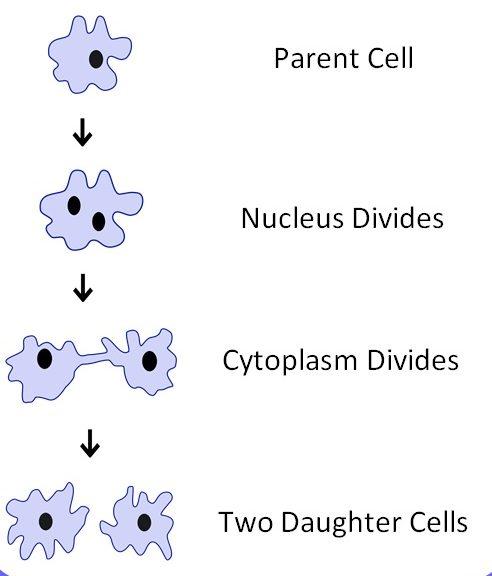
Budding
- Some species grow buds on their bodies. These buds grow into a new person. This is referred to as budding.
- The “Bud” is genetically identical to the parent but smaller in size. It may remain linked to the parent or eventually separate.
- Certain bacteria, such as Caulobacter, Hyphomicrobium, and Stella spp., fungi (Saccharomyces cerevisiae), and asexual animals, such as hydra, corals, echinoderm larvae, and some acoel flatworms, reproduce by budding.
- Example – Hydra. A bud grows from the parent hydra and eventually grows into a young hydra. When it reaches maturity, it separates from the parent body.
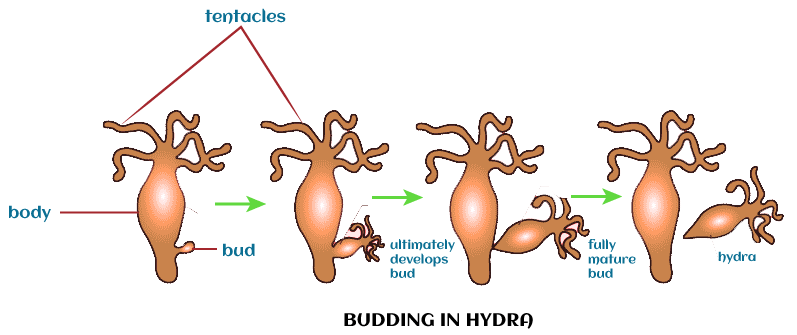
Vegetative propagation
- Plants reproduce asexually by vegetative propagation. It is the formation of a new plant from vegetative elements such as specialised stems, leaves, and roots. They then develop their own root system and develop.
- Horticulturists employ this type of reproduction to propagate economically significant plants. Pollination is not involved in the procedure. Instead, new plants are formed from vegetative components that have a specialised reproductive function.
- There are several types of vegetative propagation, which can be divided into two categories: natural and artificial. Natural ways include those that emerge from runners (stolons), bulbs, tubers, corms, suckers (root sprouts), and plantlets.
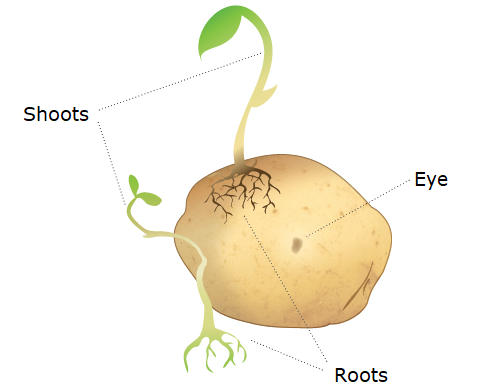
Spore formation (sporogenesis)
- Another method of asexual reproduction is spore generation. Spores, derived from the words “spor” (seed) and “genesis” (birth or origin), are dormant reproductive cells that function similarly to seeds as dispersal units.
- The spores, on the other hand, are not seeds since they lack the embryo generated by the fusing of male and female gametes. Spores have thick walls and are extremely resistant to a variety of unfavourable situations, such as extreme temperatures and low humidity.
- During adverse conditions, the organism generates sporangium, which are sac-like structures containing spores. When conditions are advantageous, the sporangium bursts open, releasing spores that germinate and give rise to new creatures.
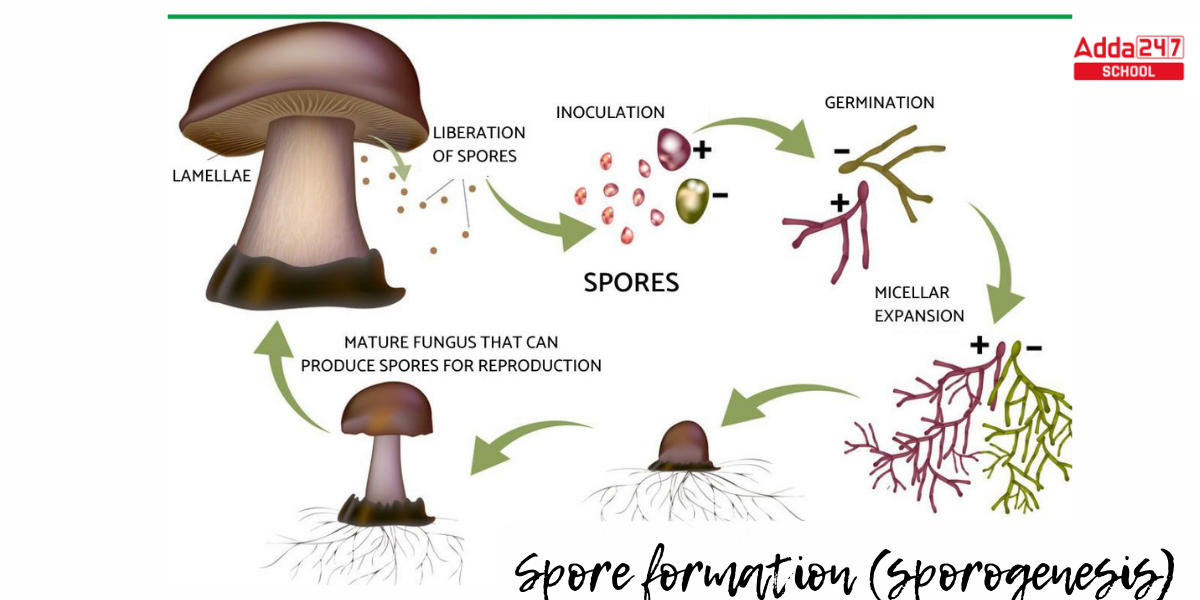
Fragmentation
- Another type of asexual reproduction is fragmentation. Fragmentation occurs when the parent organism divides into fragments, each of which can evolve into a new organism.
- The parent body fragments into two or more pieces. Each fragment eventually grows into a new individual.
- Example – Fungi (e.g., yeasts and lichens), moulds, vascular and nonvascular plants, cyanobacteria, and vertebrates (e.g., sponges, spirogyra, sea stars, planarians, and numerous annelid worms) all exhibit this.
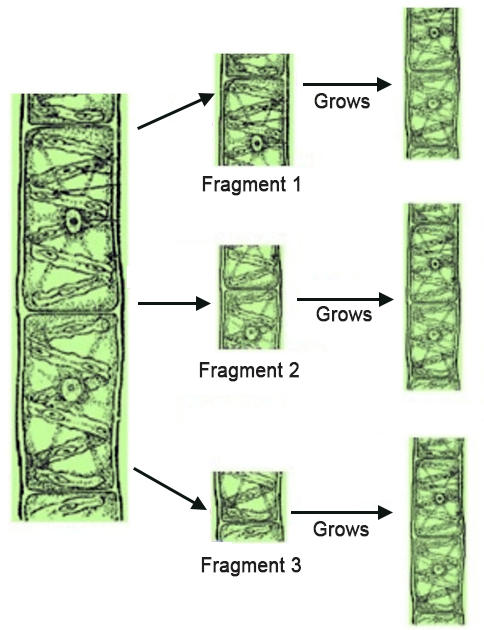
Parthenogenesis
- Parthenogenesis is a type of asexual reproduction in which the offspring grows from a female gamete without the need for earlier fertilisation by a male gamete.
- Parthenogenesis is the process through which many animals reproduce asexually. Aphids, rotifers, and nematodes are examples of invertebrates that can perform parthenogenesis.
- The procedure could be either apomictic or automictic. Apomictic parthenogenesis occurs when the egg cells generated by mitosis do not undergo meiosis and may mature to give rise to embryos directly.
The reproductive cells undergo meiosis during automictic parthenogenesis. The mature egg cell can then develop into an embryo without the need for preceding fertilisation by a sperm cell. This is an advanced form of asexual reproduction.
- Lizards, birds, snakes, sharks, reptiles, and amphibians are among the vertebrates that can breed parthenogenetically. Some of them reproduce through parthenogenesis either facultatively (they are capable of reproduction sexually) or obligately (they have no other way of reproducing other than by parthenogenesis).
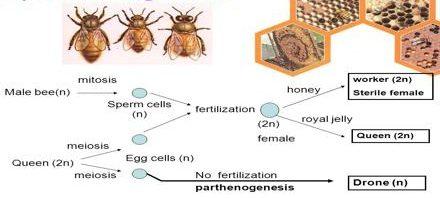
Apomixis
- Apomixis is a type of asexual reproduction in which fertilization occurs. A plant’s seed develops without the use of fertiliser.
- Apomixis is the process of recognizing and creating diploid embryos or seeds that reside within a plant without fertilization. Apomixis can also be defined as a type of asexual reproduction that occurs through seeds, in which embryos develop without fertilization, which occurs naturally in other plants.
- Apomixis can be found in hawthorns, shadbush, Sorbus, brambles, and blackberries, as well as meadow grasses, mat grass, hawkweeds, and other plants.
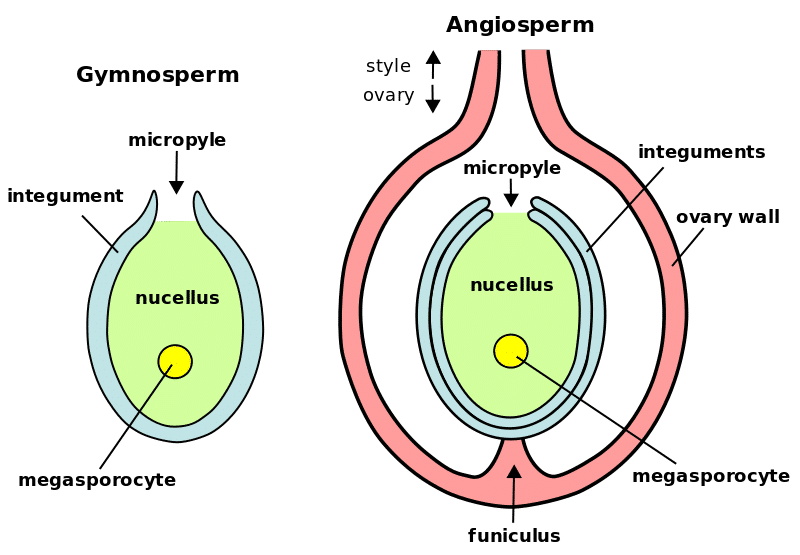
Asexual Reproduction Advantages
Asexual reproduction has some significant advantages, those are discussed below.
- Asexual reproduction is thus less expensive in terms of energy and time investment. It also allows asexuals to colonise a habitat faster than sexuals who reproduce slowly.
- Mates are not necessary. One parent is enough.
- Producing offspring in asexuals occurs more fast and is significantly easier than in sexuals. This is due to the fact that only one person is required.
- Positive genetic impacts are passed down from generation to generation.
- It can be found in a variety of settings.
- The size of the asexual population doubled with each generation, implying that the asexual population can increase faster than the sexual population. See the below image to understand better.
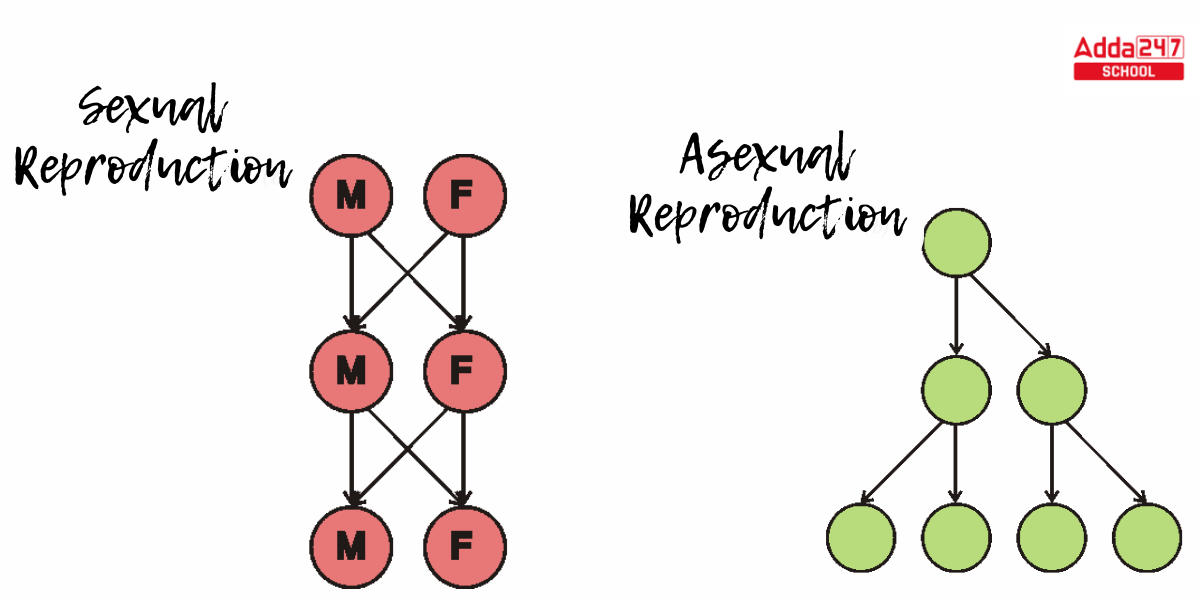
Asexual Reproduction Disadvantages
The following are the primary disadvantages of asexual reproduction.
- Because the offspring are genetically identical to their parents, diseases or nutritional deficiencies are passed down to the next generation.
- The clone inherits the same genetic information as the lone parent. If they are both exposed to a sudden perturbation in their environment, such as a virulent disease, they may be equally vulnerable because they share the same features and DNA.
- Since only one organism is involved, the diversity among the organisms is limited.
- Offspring are incapable of adapting to unfamiliar environments.
- A single environmental alteration would result in the extinction of the entire species.

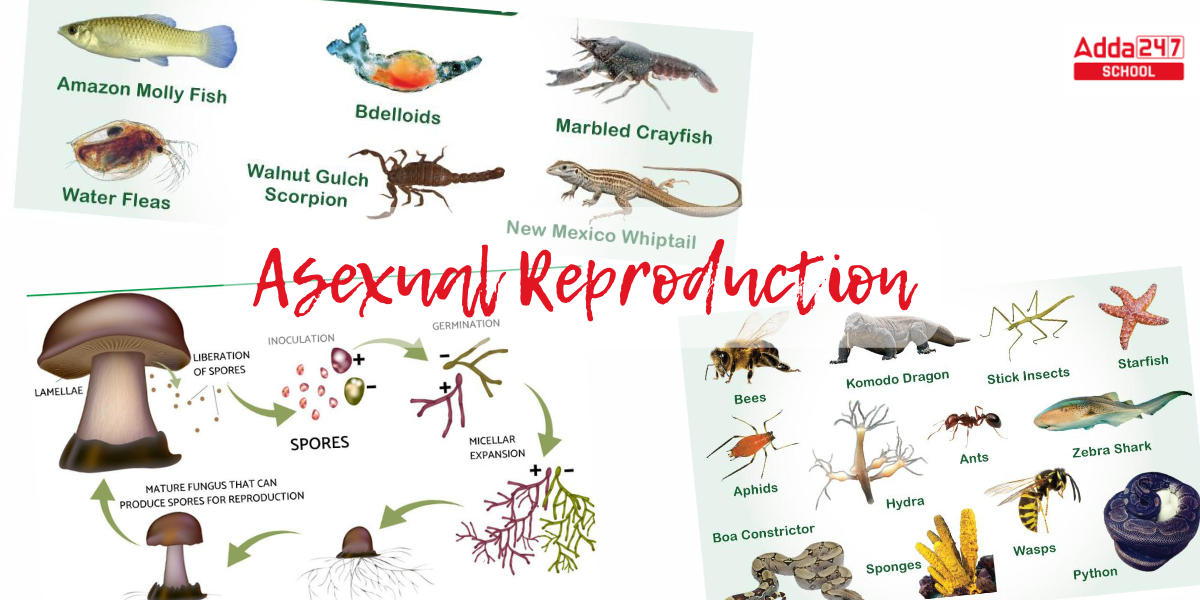
 NIT Delhi Cutoff 2024 Out, Check Categor...
NIT Delhi Cutoff 2024 Out, Check Categor...
 Gujarat Ayurved University Result 2024 O...
Gujarat Ayurved University Result 2024 O...
 SOF IMO Cut Off 2024-25, Check Previous ...
SOF IMO Cut Off 2024-25, Check Previous ...































